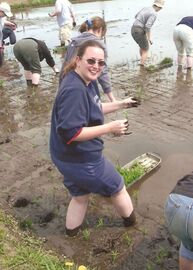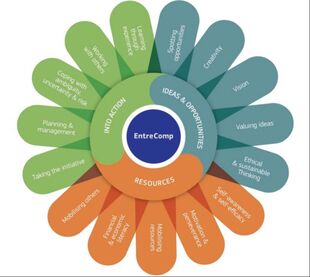
I came into this teaching programme relating my role as a teacher to that of a gardener. This metaphor still holds a year later but I now understand more of the landscape that I am working with. This metaphor is based on the theory of Experiential Learning. The gardener, like the teacher, is not in control of what the results are. The gardener is responsible for setting the conditions and making sure that everything that is needed for the plant to grow is there. For me as a teacher, my role is to make sure that all the fundamental pieces are available and understood but I am not actually responsible for the growth. That responsibility belongs to the student. Because only they can decide what they will do with what I have introduced them to. I make sure that the conditions are right for learning to happen, I am responsible for the framework content, I set achievable learning outcomes, and I find an engaging way to design and deliver the content.
As in Connectivism, I am a facilitator of knowledge “know-where” rather than “know-how”. I believe that, in this information age, that it is much more powerful to know how to find relevant and pertinent information than it is to try to remember all the information. My style includes a lot of learning by doing interaction and self-discovery of content. I am a coach that asks more questions of the students than they are used to because I pieces of the puzzle but I don’t know how they fit together for them. Their puzzle will look different from other people’s puzzles, even if the pieces are the same. The student co-create their value with me.
My goals for student learning:
I want students to learn skills that will support their whole life and their entire career. Many times these are considered the soft skills...like creativity, proactiveness, bravery, user-centredness, empathy, risk-taking, etc. These are skills that will help them in all aspects of their life, including whatever work they decide to take on. This is what is referred to as life wide learning (as opposed to life long learning). After taking a class with me, I would want them to be even a little braver in trying ideas out or putting ideas out into the world.
The methods I use to achieve these goals:
I usually have very interactive classes. Whether this is online or in a face-to-face classroom. Whether this means using post-it notes and dry erase markers or a tool like Miro for collaboration. There is group work and individual work. There is talking and walking and lots of doing. Collaboration is a very big part of my classrooms. My motto is "nothing of value is built alone" and it stand by it in teaching as well. Whether I am teaching soft skills related to the Entrepreneurial Approach/Mindset or hard skills related to the service design process, we will do so on an individual level and then in a group setting. Peer discussion is important for understanding and relating to the content. Having discussions with peers can also help the students find the relevance to the content...which in term improves their motivation for learning.
Methods for assessment of student learning:
Because what I teach is so interactive and based on experiential learning, it is pretty easy to spot someone who isn't learning. Much of the daily learning takes place in an interactive way (either interacting with me, the teacher, or with their peers). The processes that I am teaching can move in any direction but even backwards can be considered forwards. In terms of the more definite skills, this is when we can turn to the Entrecomp competence framework that helps with assessing skills related to the entrepreneurial mindset. This is a comprehensive framework that sets out step-by-step how to assess typical skills such a creativity or initiative. It contains 3 competence areas, broken down into 15 measurable and assessable competences with a 4 level framework.
As in Connectivism, I am a facilitator of knowledge “know-where” rather than “know-how”. I believe that, in this information age, that it is much more powerful to know how to find relevant and pertinent information than it is to try to remember all the information. My style includes a lot of learning by doing interaction and self-discovery of content. I am a coach that asks more questions of the students than they are used to because I pieces of the puzzle but I don’t know how they fit together for them. Their puzzle will look different from other people’s puzzles, even if the pieces are the same. The student co-create their value with me.
My goals for student learning:
I want students to learn skills that will support their whole life and their entire career. Many times these are considered the soft skills...like creativity, proactiveness, bravery, user-centredness, empathy, risk-taking, etc. These are skills that will help them in all aspects of their life, including whatever work they decide to take on. This is what is referred to as life wide learning (as opposed to life long learning). After taking a class with me, I would want them to be even a little braver in trying ideas out or putting ideas out into the world.
The methods I use to achieve these goals:
I usually have very interactive classes. Whether this is online or in a face-to-face classroom. Whether this means using post-it notes and dry erase markers or a tool like Miro for collaboration. There is group work and individual work. There is talking and walking and lots of doing. Collaboration is a very big part of my classrooms. My motto is "nothing of value is built alone" and it stand by it in teaching as well. Whether I am teaching soft skills related to the Entrepreneurial Approach/Mindset or hard skills related to the service design process, we will do so on an individual level and then in a group setting. Peer discussion is important for understanding and relating to the content. Having discussions with peers can also help the students find the relevance to the content...which in term improves their motivation for learning.
Methods for assessment of student learning:
Because what I teach is so interactive and based on experiential learning, it is pretty easy to spot someone who isn't learning. Much of the daily learning takes place in an interactive way (either interacting with me, the teacher, or with their peers). The processes that I am teaching can move in any direction but even backwards can be considered forwards. In terms of the more definite skills, this is when we can turn to the Entrecomp competence framework that helps with assessing skills related to the entrepreneurial mindset. This is a comprehensive framework that sets out step-by-step how to assess typical skills such a creativity or initiative. It contains 3 competence areas, broken down into 15 measurable and assessable competences with a 4 level framework.

